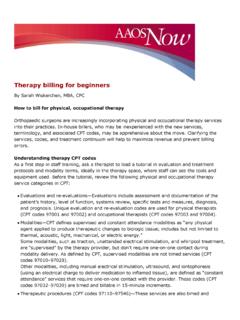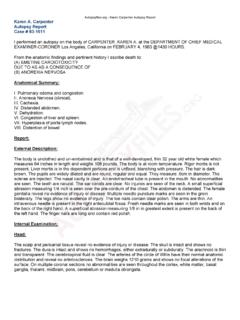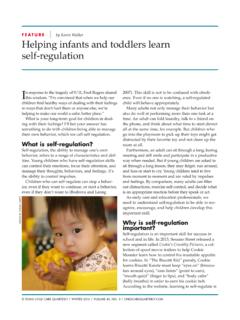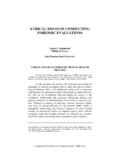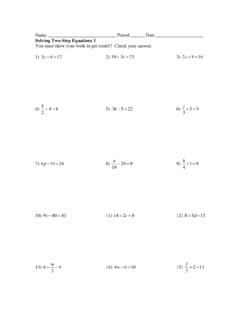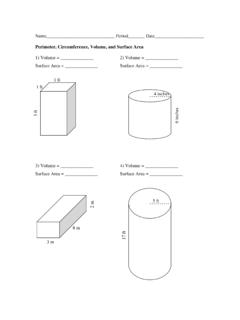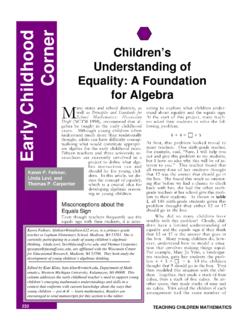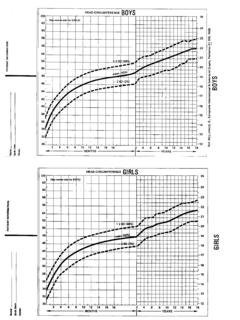Transcription of By Kim Pollock, MS, RN, MBA, CPC Procedure …
1 Coding/Billing By Kim Pollock, MS, RN, MBA, CPC. Procedure Coding Made Simple Five principles will help you capture appropriate charges for spine surgeries. It seems like coding spine cases is as complicated as doing the surgery, said a spine surgeon at his first coding training session with me. Spine Procedure coding can make even the most confident coder squirm. But spine Procedure coding doesn't have to be difficult. In fact, it's quite formulaic. Follow these five principles and spine Procedure coding will go from scary to simple. 1. Choose standalone codes to describe decompression/discectomy. Decompression is the general term to describe removal of the spinal disk, bone, or tis- sue causing pressure and pain. Often, this is the only Procedure performed. Exam- ples include: laminectomy to decompress spinal canal and/or nerve roots ( , 63001- 63017, 63045-+63048), discectomy to decompress spinal canal and/or nerve roots ( , 63020-+63035, 63040-+63044, 63055-+63057), corpectomy ( , 63081- +63091), fracture repair ( , 22325-+22328), etc.
2 CPT designates the decompression codes as being per vertebral segment or per in- terspace. Decompression occurs at the interspace for discectomy codes ( , right L4-L5 interspace). Discectomy is a single, standalone code, such as 63030 Laminoto- my (hemilaminectomy), with decompression of nerve root(s), including partial facetectomy, foraminotomy and/or excision of herniated intervertebral disc; 1 interspace, lumbar. But decompression of the spinal canal can be coded per vertebral segment (63001-63017), or per level of foraminotomy ( , decompression of the L4 exiting nerve root via partial laminectomy at L4 and partial laminec- tomy at L5, with foraminotomy at L4-L5, is reported using one code: 63047 Laminectomy, facetectomy and foraminotomy (unilateral or bilat- eral with decompression of spinal cord, cauda equina and/or nerve root[s], [eg, spinal or lateral recess stenosis]), single vertebral segment; lumbar). illustration by iStockphoto A-Digit Discern whether the approach was posterior or anterior to choose the correct code.
3 Table A illustrates commonly used, standalone decom- pression codes for spine surgery. Takeaways: Spine coding is easier than it seems, if you approach it as formulaic. Five principles can help make spine surgery coding simpler. Be wary of exceptions. 42 AAPC Cutting Edge Coding/Billing: Spine Table A: Standalone decompression codes for spine surgery Approach/ Procedure Cervical Thoracic Lumbar Sacral Posterior Laminectomy 63001, 63015, 63003, 63016, 63005, 63017, 63011. 63045, +63048 63046, +63048 63047, +63048. Posterior Discectomy 63020, +63035, None 63030, +63035, None 63040, +63043 63042, +63044. Posterior Fracture Repair 22326, +22328 22327, +22328 22325, +22328 None Corpectomy 63081, +63082 63085, +63086, 63087, +63088, None 63087, +63088, 63090, +63091. 63090, +63091. From the operative note, identify which decompression/discectomy activity the sur- geon performed. Then, choose an appropriate standalone code and any associated add- on codes (noted by the + sign in CPT ) for the decompression.
4 Remember, corpecto- my (removal of part or all of a vertebral body) codes include the discectomy at the lev- el above and below the corpectomy. Documentation also should reflect removal of at least 50 percent of the cervical vertebral body, or 33 percent of the thoracic and lum- bar vertebral bodies, to use the corpectomy codes. Example 1. A 68-year-old male who has lumbar spinal stenosis at L5-S1 undergoes partial lami- nectomies at L5 and S1, with medial facetectomy and foraminotomy at L5-S1. This is reported with 63047. Example 2. A 33-year-old female herniates an intervertebral disc on the right at L4-L5 while lifting her 4-year-old child. She undergoes minimally invasive hemi-laminotomies and fo- raminotomy with discectomy at L4-L5 on the right side. This is reported with 63030. 2. Was a fusion (arthrodesis) performed? If the answer is no, go to principle No. 5. If the answer is yes, choose the standalone CPT code for the fusion (synonymous with arthrodesis, or the joining of two or more vertebrae).
5 Fusion is the merging of adjacent parts; therefore, coding a single fusion segment (22612 Arthrodesis, posterior or posterolateral technique, single level; lumbar (with lat- eral transverse technique, when performed)) involves two adjacent vertebral segments (L4 and L5). Be careful: There is a single combined decompression/fusion code: 22551 Arthrode- sis, anterior interbody, including disc space preparation, discectomy, osteophytectomy and Discern whether the approach was posterior or anterior to choose the correct code. September 2013 43. Coding/Billing: Spine As with other graft codes in CPT , the spinal bone graft codes are reported for harvesting the bone graft. decompression of spinal cord and/or nerve roots; cervical below C2. Do not use a separate Cervical below C2. standalone anterior cervical arthrodesis code (22554 Arthrodesis, anterior interbody technique, including minimal discectomy to prepare interspace (other than for decompres- Wires sion); cervical below C2) with the separate anterior cervical discectomy/decompression code (63075 Discectomy, anterior, with decompression of spinal cord and/or nerve root(s), including osteophytectomy; cervical, single interspace) at the same spinal level.
6 Use the combined decompression/arthrodesis code, 22551, instead. Discern whether the approach was posterior or anterior to choose the correct arthrod- esis code(s). The standalone code covers the first segment of fusion, and the associat- Bone graft ed add-on codes are used for additional levels of fusion. For example, a posterior fu- sion at L4-S1 is coded as 22612 (L4-L5) and +22614 Arthrodesis, posterior or posterolat- eral technique, single level; each additional vertebral segment (List separately in addition to code for primary Procedure ) (L5-S1), not 22612 (L4), +22614 (L5), and +22614 (S1). Bone chips See Table B for commonly used arthrodesis codes in spine surgery. Locally obtained Table B: Commonly-used arthrodesis/fusion codes in spine surgery grafts Physician uses Approach Cervical Thoracic Lumbar graft, wires to fuse vertebrae Posterior 22600, 22610, 22612, +22614, 22630, Wire Bone +22614 +22614 +22632, 22633, +22634.
7 Fixation chips Anterior 22554, 22556, 22558, +22585. +22585 +22585. Anatomical Illustrations 2012, Optuminsight, Inc. 3. Choose the appropriate Report 22600 for cervical;. Lumbar report 22610 for thoracic; add-on bone graft code with fusion. report 22612 for lumbar; Because a fusion was performed, you must include a bone graft code. As with other report 22614 for each additional segment graft codes in CPT , the spinal bone graft codes are reported for harvesting the bone graft. The work of placing the bone graft is included in the arthrodesis/fusion codes. All spinal bone graft codes are add-on codes. Choosing one is easy: There are only five, as shown in Table C. CPT guidelines allow for reporting each bone graft code once per operative session. Table C: Commonly-used add-on bone graft codes in spine surgery Exception to Principles Type Morselized Structural No. 1 and No. 2 Allograft (donor bone). Autograft (patient's bone).
8 +20930. +20936, +20937. +20931. +20938. A single, standalone CPT code describes com- bined decompression and fusion activity in the From the operative note, determine whether the bone graft was an allograft or an au- anterior cervical spine: 22551. The add-on code tograft, and whether it was a morselized (bits or pieces) or structural (wedge or chunk). is +22552. Do not report 63075 and 22554. together for this Procedure when performed at bone. It helps to know what the bone type documented in the operative note looks like. the same spinal level (by one or multiple sur- Examples of +20930 Allograft, morselized, or placement of osteopromotive material, for geons). Use the combined code(s) 22551 and spine surgery only (List separately in addition to code for primary Procedure ) include de- +22552 instead. mineralized bone matrix (DBM or DBX) and bone morphogenic protein (BMP). Ex- 44 AAPC Cutting Edge Coding/Billing: Spine Choose anterior instrumentation codes (+22845- +22847) based on the number20930-30.
9 Of vertebral segments the hardware (typically, a plate) spans. amples of +20931 Allograft, structural, for spine surgery only (List separately in addi- tion to code for primary Procedure ) include a fibular strut graft and a machine thread- ed bone dowel. Examples of +20936 Autograft for spine surgery only (includes harvesting the graft); lo- Cancellous bone cal (eg, ribs, spinous process, or laminar fragments) obtained from same incision (List sepa- rately in addition to code for primary Procedure ) include crushed spinous process and/or Bone is morselized lamina bone or rib harvested through the same exposure. An example of +20937 Auto- (chipped) for 20930. graft for spine surgery only (includes harvesting the graft); morselized (through separate skin or fascial incision) (List separately in addition to code for primary Procedure ) is cancellous iliac crest bone; +20938 Autograft for spine surgery only (includes harvesting the graft).
10 Structural, bicortical or tricortical (through separate skin or fascial incision) (List separate- ly in addition to code for primary Procedure ) is bicortical or tricortical iliac crest bone. Important: Because bone graft codes are add-on codes, per CPT guidelines, they are never reported with modifier 62 Two surgeons. Bone is prepared for 4. Was instrumentation used in the fusion? structural If the answer is no, go to principle No. 5. grafting for 20931. If the answer is yes, choose the appropriate add-on code(s) for the instrumentation, also known as hardware (see Table D on the next page). Review the operative note to determine where the instrument was used, and whether it was non-segmental, seg- mental, or intervertebral. Anatomical Illustrations 2012, Optuminsight, Inc. Posterior instrumentation is categorized as non-segmental or segmental. Non-segmen- Allograft bone is harvested, usually from a tal instrumentation (+22840 Posterior non-segmental instrumentation (eg, Harrington cadaver, and prepared and inserted for rod technique, pedicle fixation across 1 interspace, atlantoaxial transarticular screw fixa- grafting purposes; 20930 is coded for tion, sublaminar wiring at C1, facet screw fixation) (List separately in addition to code for morselized chips of bone; 20931 is coded for primary Procedure )) is defined by CPT as fixation at each end of the construct and bone intended for structural grafting may span several vertebral segments without attachment to the intervening segments.
